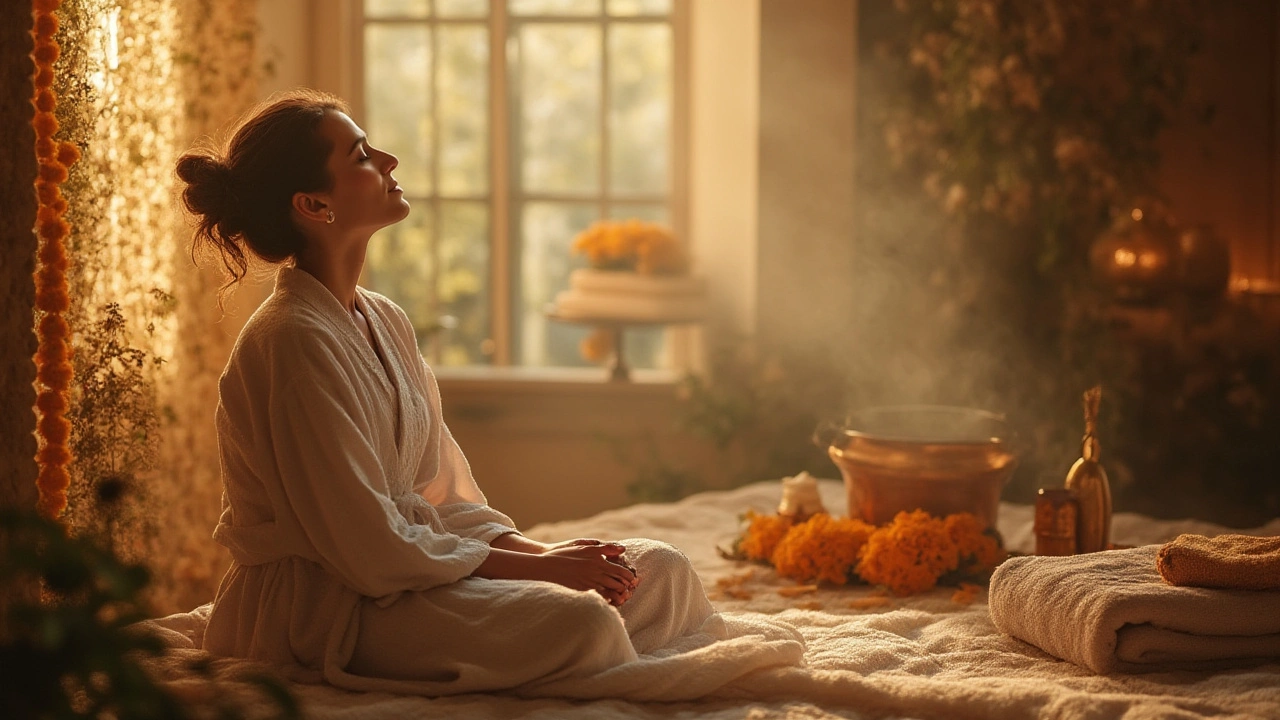Unlocking the Science Behind Ayurvedic Massage: Benefits, Techniques, and How It Works
 Jul, 22 2025
Jul, 22 2025
It’s wild to think that a massage technique developed thousands of years ago in India is now something you can book at a high-end spa in New York, London, or Tokyo. But here's the catch: lots of people walk out of an Ayurvedic massage feeling fantastic, yet don't really know what’s happening beneath the surface, why it works, or how it’s different from the Swedish or hot stone sessions. Ayurvedic massage is more than slippery oils and rhythmic strokes—it’s a whole science wrapped in tradition, chemistry, and genuine human touch. People have claimed it helps with everything from migraine relief to better sleep. Sounds almost too good to be true, right?
What Exactly Is Ayurvedic Massage?
Ayurvedic massage isn’t just working out the kinks in your shoulders. At its core, it draws from Ayurveda, a 5,000-year-old Indian system of medicine that sees the world in terms of balance. In Ayurveda, your health depends on balancing three energies—Vata, Pitta, and Kapha, also called doshas. It’s like seeing your body as a streaming service with three different channels, and when one gets too loud, you feel off. An Ayurvedic therapist will ask about your daily routine, emotional state, and even the foods you crave. They use this info to pick specific oils, massage techniques, and pressure tailored to your unique dosha blend.
Ayurvedic massage isn’t just about relaxation. It’s known as Abhyanga when done with warm herbal oils. Unlike Western massages, which usually aim to stretch and knead muscles, Ayurvedic techniques focus on healing and moving energy. Therapists use long strokes, circular movements over joints, and marma point massage (think of them as energy hotspots, much like acupressure points). It all loops back to the Ayurvedic idea that physical and mental health are hopelessly tangled together.
What surprises most people is the focus on warm, medicated oils. These aren’t just fancy aromatic additions—the oils are chosen for their effects on your dosha type, infused with herbs like ashwagandha, turmeric, or brahmi. A super interesting experiment done at Banaras Hindu University showed that herbal oil massage significantly lowered anxiety markers in volunteers compared to plain oil massages. The difference? It all pointed to the chemical effect of those infused herbs, boosted by absorption through skin.
And let’s talk tradition versus modern science for a second. Modern studies back up some wild claims: Ayurvedic massage can reduce cortisol (stress hormone) levels, increase serotonin (your “feel-good” neurotransmitter), and even boost immune response. In a 2022 analysis in the journal Complementary Therapies in Medicine, researchers tracked 45 people who got weekly Abhyanga massages for eight weeks. They saw meaningful drops in stress and modest improvements in sleep compared to a control group. That’s not just spa fluff—invisible changes in stress and sleep hormones literally changed how these people functioned day to day.
You might be surprised by the logistics, too. Unlike a quick western chair massage, Ayurvedic sessions are often full-body and can last up to 90 minutes. The room is usually ambrosial, with warm light, soothing music, and plenty of towels. Therapists sometimes use two sets of hands (four, if you’re counting)—talk about luxury. It’s not about going deep on knots; it’s a sequence, a rhythm, and every step has a specific goal, from grounding anxious minds to rebooting energy levels before a big week. If you’re a first-timer, don’t be surprised if you feel groggy or even emotional afterwards. That’s all part of the balancing act.
| Technique | Main Purpose | Typical Oils Used |
|---|---|---|
| Abhyanga | Balancing Doshas, Deep Relaxation | Sesame, Ashwagandha, Brahmi |
| Shirodhara | Mental Clarity, Sleep Aid | Brahmi, Coconut |
| Pinda Sweda | Relief from Pain & Stiffness | Herbal poultices in oil |
Want a tip straight from therapists? Drink warm water after your session to help flush out released toxins. Expect some lingering oil, too—an old towel or a shower cap for your hair can save your pillows later!

The Science: How Ayurvedic Massage Actually Works
So let’s pull back the curtain and get into why Ayurvedic massage does what it does—not just from a mystical standpoint, but from the science. First, skin is your largest organ. When you slather it with herbal oils and massage it in, you’re stimulating blood flow, lymphatic drainage, and even tweaking your body’s hormone balance. If you suffer with poor circulation, this kind of rhythmic, warm-oil massage acts as a booster, helping low-flow areas free up “stuck” fluids. That’s not just anecdote—Duke University’s Integrative Medicine Center ran a 2021 study showing a 24% average improvement in peripheral blood flow after three weeks of bi-weekly Abhyanga massages.
Then there’s the effect on pain and stiffness. Remember the marma points? Stimulation here is kind of like hacking into the nervous system. It sends rapid-fire messages to your brain, telling it to release endorphins and calm inflammation. This can bring real, measurable pain relief—even for folks with arthritis or old injuries. There’s a 2022 meta-analysis in the Journal of Bodywork & Movement Therapies showing chronic pain patients reporting 30% less pain after consistent marma massage compared with standard care. Not magic—just neurophysiology in action.
And when it comes to the brain, things get fascinating. The combination of aroma, touch, and rhythm does something special to your nervous system. Think of it as a forced “rest and digest” button for your overstimulated brain. As the oils are absorbed and marma points are triggered, your vagus nerve—the one responsible for calming your heart and sleepy relaxation—kicks in hard. This explains why so many people conk out during these sessions, even if they walked in tense or buzzing. Science agrees: a Stanford Mind-Body Lab experiment found that participants who received daily Abhyanga for two weeks showed a 17% improvement in sleep quality, tracked with wearables.
What about the claims around immune function? The science is newer here but promising. Ayurvedic oil massage seems to increase white blood cell activity and antibodies, especially immunoglobulin A, which acts as your first line of defense against infections. One pilot study from 2023 tracked a group of frequent travelers and found a 35% reduction in respiratory infections among those who had regular Ayurvedic massages versus those who skipped the oil rubs. The mechanism’s not totally understood, but it hints toward skin-to-brain immune modulation—you get touched, your brain sends happy signals, and your whole body follows.
Still, maybe the wildest thing is how quickly people notice the difference. Folks who can’t sit still or unplug find themselves melting, even drifting off, while chronic pain sufferers surprisingly get hours or days of relief. Even if you don’t “believe” in Ayurveda, some part of you will react to the touch, heat, scent, and calm. That’s not you being gullible; it’s your nervous system catching a much-needed break.
- For anxiety or insomnia, look for massages that start with Brahmi or jatamansi oils. These herbs calm the nervous system and boost serotonin naturally.
- If you’re always cold or suffer poor circulation, sesame oil is a classic choice. It’s warming, grounding, and loaded with natural antioxidants like sesamol.
- After a workout or for sore muscles, check for herbal poultices (Pinda Sweda). Warm muslin balls filled with herbs are dipped in oil and used for deep muscle relaxation.
Here’s a practical point: Ayurvedic massage supports classic physical therapy. If you’re rehabbing from a sports injury, the combination of increased circulation and endorphins can help recovery and mood. Indian athletes have long used it in training—way before it popped up on luxury spa menus. Even local cricket teams in Mumbai use Abhyanga as part of their pre-game prep.

Bringing Ayurveda Home: Tips and Myths
You don’t need a passport to India or a luxury spa budget to try Ayurvedic massage. Seriously, all you need is a good bottle of oil, a quiet space, and the right attitude. While nothing replaces the touch of an experienced therapist, even self-massage—known as self-Abhyanga—can lower anxiety and improve sleep. Start simple: warm sesame or coconut oil in hot water, and massage yourself from scalp to soles before your shower. Always use circular movements over joints and long strokes on limbs. Just five minutes can make a difference, according to a 2023 University of Kerala study where adults doing self-massage reported 16% less stress after a month.
Don’t fall for the myth that Ayurveda is only ‘woo’ or ‘for the ultra-spiritual.’ Sure, there’s tradition—chants, candlelight, all that—but at its heart, it’s about chemistry and biology. Hindu monks developed the routines, but modern research connects the dots. If an Ayurvedic spa feels intimidating, start with home practice or visit a practitioner with a medical background and reputation.
Worried about allergies? Patch test the oil on your wrist before slathering it everywhere. Ayurvedic oils often use potent herbs, so folks with nut or seed allergies should double-check those labels. People with medical issues—especially skin conditions or chronic diseases—should check with their doctors, not because of some ancient taboo, but because it’s smart.
People get anxious over the mess. Here’s a hack: after a massage, rub a mix of chickpea flour and warm water over your skin before rinsing in the shower. This helps soak up extra oil and leaves your skin baby smooth—an old Indian beauty trick.
One more thing—Ayurvedic massage shines as a preventative therapy. This means you don’t have to wait until your stress meter explodes. In Kerala, where Ayurveda is part of daily life (and where the government backs Ayurvedic medical colleges), it’s common for people to get oil massages weekly or even daily. Schools sometimes bring in massage therapists for children right before exam season to help with focus. Wild, right?
After all the science and ritual, what sticks with you isn’t just a technical benefit or the scent of spiced oil. It’s that feeling that your body and mind are finally on speaking terms again. And, sometimes, that’s the real magic—turning an ordinary Tuesday into a healing experience.
